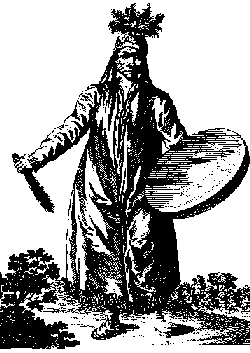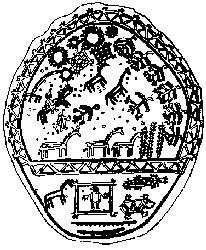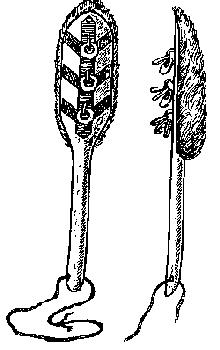

Female Shaman, Krasnojarsk region, 1780 |
Shamanism, widely spread among Tuvinians in recent times, has been analyzed right up to the very last time only by ethnographers, mainly as a religious belief, i.e. the reflection of advanced animistic notions. As the scientists - Tuvinologists L.P. Potapov, V.P. Dyakonova, E. Taube, S.I. Weinstein, M.B. Kenin-Lopsan, N.A. Alekseev show in their historical ethnographic researches, shamanism was a natural part of the whole spiritual and cultural life of the Tuvinian people. This is mainly how they considered the ceremonies of shamanic ritual and functions of their required attributes; drum - animated into a shaman's riding animal, his ritual head-gear, ritual mask and ritual clothes, covered with eerens - the figurines of animals, birds, snakes, personifying spirit-helpers and in conclusion, poetic texts of shaman's melodious recitational appeals to spirit-helpers and hostile evil-spirits and their world outlook. Fixed tape-recorded musical / vocal and instrumental / pieces and syncretically correlated with them, pantomyme - choreographic ritual expressive means of Tuvinian shamans have not attracted researchers' attention yet, even in the aspect of reflecting religious beliefs in them, saying nothing of the aesthetic aspect / musical-theatrical and professional - artistic ones. |
Whereas art critics and psychiatrists have lately examined very intently shamanic and bewitching ceremonies of Yakuts, Buryats, Altai, American Indians and African ethnic groups, which are very similar to Tuvinian rituals. Tuvinian shamans, dancing and imitating animals and birds, posessed a striking gift of incarnating and a striking ability of constant changing their inward and outward appearance. During a ritual period with and without a mask, they talked and recitated musically, spoke their assistant's voice, conversed with him, imitated skillfully the voices and cries of animals and birds, their spirit-helpers / Siberian stag, ram, goat / and evil spirits / owl, crow, cuckoo/.
According to the shamanic concept, the Universe is divided into the three worlds, inhabited by people, animals, birds, various deities and spirits.
Tuvinians believed in aza-spirits, who killed people and caused diseases. It was the shaman, mediator between supernatural and human beings, who could communicate with spirits, see them, conquer in a fight and give back a sick man's soul. Spirit-helpers were ak-ereem amd Kyrgyz ereen. They helped to associate with sky-spirits.
According to popular beliefs, there existed the Lower world and its head was called erlic orany / the devil land /. Shamans came from shaman-ancestors, spirits of the earth and water, devil spirits, albyses and aza. The expert on shamanism M.B. Kenin-Lopsan says that "a person becoming an albys' victim falls ill immediately - faints away, gets absent-minded, sometimes goes mad." (Kenin-Lopsan M.B., Ritual Practice and Folklore of Tuvinian Shamans, Moscow, 1989, p 17) The shamans coming from spirit-ancestors were considered the most powerful. These shamans during a shamanic ritual appealed to their ancestors. The shamans coming from the sky-people sang the earthly things, which were dependant on them.
M.B. Kenin-Lopsan is one of the most experienced experts on shamanic ritual poetry. He showed perfectly the performance art of Tuvinian shamans. Shamanic rituals written after shamans themselves, their tricks, fortune-telling were published in his author's book. / M.B. Kenin-Lopsan, cit. book, p. 21-35/.
Shamans, according to Sternberg, - are people most suffering from various kinds of hysteria and are easily hypnotiued and autosuggested (Sternberg, L. Ya., Religious Views of Oroches of the Tatar Strait, collection "Primitive Religion" /.) V.G. Bogoraz tells that many of Tchukcha shamans, whom he met "were almost hysterical and some of them were even half-mad." Once could often observe their explosive outbursts, unendurance, frequent quarrels with their neighbours, involuntary face jerks. (Bogoraz V.G., Tchukches, Vol. II, Religion, Russian Edition, 1939. English Version published in 1912).
|
Many informants report how most skillful shamans excerted influence during a shamanic ceremony on their spectators with numerous tricks relating rather to a circus art, than to an artistic one / as. A.D. Avdeev remarks/. For instance, Tuvinian shamans pierced them-selves with a knife, licked burning hot iron, took into the mouth burning hot coals or walked bare-foot about them. V.G. Bogoraz wrote that shamanic rituals "were marvellously combined with ecstasy and the coolest cheating." (Bogoraz V.G. cit. book, p. 182) But nevertheless such tricks were of minor significance in shamanic rituals of Tuvinians, Yakuts, Altai, Nanai, Buryats, Evenks and many other ethnic groups of Siberia. They, these tricks, had nothing to do with the essence of the shamanic ritual, the more so only few shamans, fond of circus tricks, did them to strengthen spectators' trust in their omnipotence. |
 Shaman drum from Altai |
This is the reason why these tricks mustn't be compared with the expressive means of shamans' artistical art, which were of decisive importance in the mystic shamanic ritual. They must be related ot those which were the necessary minimum of every shamanic ritual connected with its main point and which were exercises not only by Tuvinian shamans, but shamans of other Siberian ethnic groups - Saams, Eskimoes and many other healers and wizards if American Indians and Negro tribes of the African continent, functionally kindred to them..
But ethnographers confine themselves to describing not only outer forms of the given ceremony and are not almost concerned about the main point of the ritual which psychiatrists, musicologists and art critics have lately paid attention to.
One of the principle expressive means of the shamnic art was its music. Among Tuvinians some shamans knew very well heroic legends, fairy-tales and myths. The belief in the magic force of tale-telling was so great that Tuvinians took a tale-teller with them while hunting and shared their quarry with him. Among the ethnic gorups of Sayan-Altai there were widely spread myths about the love of mountain spirits to music and fairy-tales. The collector of Tuvinian folklore O.K. Daryma tells that spirits - mountain masters enjoy songs and playing of musical instruments. Mountain spirits listening with delight to music and singing, present hunters with a rich quarry. It is confirmed by P.A. Troyakov in his book "Hunting and Magic Functions of Tale-Tellung among Khakass". According to shamans' concepts, woods, mountains and even encampments had such spirits.
In order to live a long and healthy life, man mustn't cause pain to nature: break trees, pick flowers. The mistress of the land was believed to live on large larch and birch-trees, in the taiga uplands. Therefore no larch and birch-trees were ever felled. On the contrary, different rags and shreds were hung on these trees and decorated with various cloths. When felling a tree, Tuvinians prayed and asked to be forgiven. On the place where the felled tree had grown, a person left its buds, filled them with soil and pronounced the following charm:
 Sojotan Drum Stick |
The nine peaks of mine, The seven gods of mine, Forgive me. My people need it That's why I am felling The noble tree of mine. I am felling The fumigation rite I'm performing. Besprinkling rite I'm performing. But because I have to. Not only to fell, I have been felling I have felled it to use it Oh, God, gracious; For ever you won't disappear. Your cones will grow up Though you are gone For ever you won't be gone An abundant tree like you will grow up Oh, God, gracious! Kyrgyz Z.K., "Tuvinian Traditional Aldysh Yoreeldery", Kyzyl, 1990, p. 63-64 |
The characteristic feature in shamans' activities is a close connection with musical art and art in general. Shamans were guardians and singers, passing on a singing art from generation to generation. Listening to shamanic ceremonies, people learned how to intone music, their native sound row, melodies. And so the reflection of feelings, habits, needs, interests, tastes and skills of people in shamanic music is quite natural. In a shamanic ritual one can reveal lyrical pages, significant in their melodious strength, harmony of musical rhythms and refinement of the language.
Tuvinian Shamanism was widely and closely connected with drama, fine arts and other forms of art. As the well-known art and literary critic A.K. Kalsam writes, shamans were actors and poets by nature. Where a shaman used to make his ritual / as Saaya Samru, an informant from the village of Mygyr-Aksy, Mongyn-Taiga District, told me in 1979/, young people made their appointments in order to listen to his singing. Shamans were very gifted people. They mimicced, gesticulated, doing their best to set off the speach of every folklore character by pronounciation, imitating the voices of spirits, animals, beasts, birds / ram, goat/ in different ways. Sometimes the onomatopoeia was masterly.

As any Tuvinian performed khoomei /throat singing/ and enjoyed nice singing, he listened with pleasure to a shaman, famous for his vocal skill. Tuvinian melodies sygyt, kargyraa or khomus-playing were the expressive means of the shamanic folklore. As far as style features are concerned, they were quite a peculiar genre, unlike melodious recitations. As the researcher of the Tuvinian traditional music A.N. Aksenov maintained, - Lulling impact of melodious recitation melodies / Lullabies and rite of animal domestification / was caused apparently by the monotonous type of recitation itself as well as interchanging tremolo / at the major second and minor third/ by the end of each phrase. Long sounding of such monotonous influenced the nervous system. In the past Tuvinians beliefed in the invoking force of such recitations. It's interesting to know, that Tuvinian shamans used the same type of melodious recitation before. Their ritual melodies are similar to the melodies of lullaby recitations as well as to those accompanying an animal domestication rite.

A.N. Aksenov, Tuvinian Traditional Music, Moscow 1964, p.22-24/. He gives some patterns of shamanic melodies in different parts of Tuva to show it. According to a melodious style they are quite various and cannot be brought together one definite tye as it sees from the comparison of the above-mentioned shamanic recitation patterns with other ones. We will see, that Yakuts, ethnically related to Tuvinians, have the same tremolo intoning at the major second, minor third and also at the major third in melodic recitations of the Olonkho epic genre. / E.E. Alekseev, Problems of Forming a Fret on the Material of a Tradition Song. M. Muyzka, 1976. Note examples at p. 50-52, 127 -128 /
A shamanic ceremony is not only a religious ritual. It is a traditional vocal art, which is confirmed by a fret, sound row, timbre and other peculiarities of the Tuvininan vocal intoning. This singing of appeal in the honour of earth spirits and gods, dances to the sounds of the caste drum, dungur, ringing of metallic pendants on shaman's clothes make a striking impression. At the same time they were of great significance int he spiritual life of shamans, served as a means for fighting against devil forces of the other world. In the past Tuvinians asked shamans to help them on various occasions, but most of all when being sick or on the 7-th or 49-th day after a person's death. The soul of the deceaesed is believed to hace already left the body between the 7-th and 49-th day, but is always at home or nearby. 49 days later a person's soul leaves his relatives for ever. That's why a funeral feast was made, with the invitation of a shaman, who spoke with the soul of the deceased, treated it, sent away to the outer world. The main point of fumigating was the following: burning hot coals were thrown about a flat stone, where a handful of juniper artysh was put. If the censer began to smoke at once, it meant to come to life. Then melted butter, meat was added there. The shaman fumigated the drum and then his clothes, lifting in turn his feet. The censer was considered to clean the things. At the end of a shamanic ritual the censer was taken out of the yurta.
The ritual of every shaman consisted of fortune telling with the help of a beetle, for eliminating danger, as Kenin-Lopsan explains: if the beetle fell down on a fir side up, a patient must recover, that is, one had anaa tooren - the fate of well being. If the beetle fell down in the obverse side up, it was uigu tooren - an ill fate. Believers piously observe these traditions. Shamans, as representatives of the active forces in the spiritual life, whom the prosperity of a family, tribe was dependent on, guessed the past somehow, foretold the future, posessed some knowledge and could meet spiritual wants of their county-fellows.
No doubt, shamanism is a definitive way of thinking. Shamanic learning is a phylosophy, not yet arranged properly. The phylosophy, coming from the people's life itself, met intellectual and psychological feelings.
The music of shamanism, born as a spiritual need of the people is an integral part of the ancient Tuvinian culture.
International Scientific Center Khomei of the Ministery of Culture of the Republic of Tuva.
Printed in Kyzyl in 1993 in a circulation of 3000 at the printing house 'Novosti Tuvi'.
translated by Rollanda Kongar.